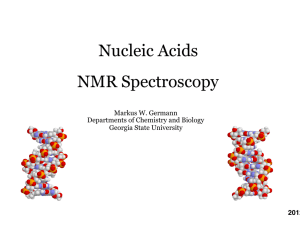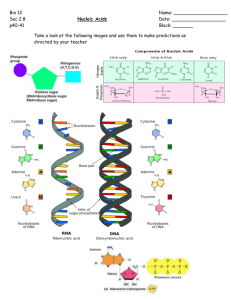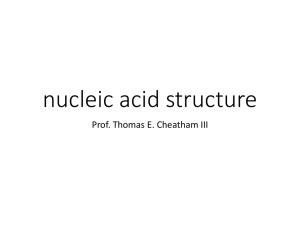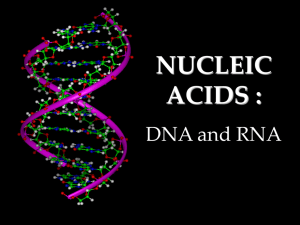Nucleic Acids NMR Spectroscopy Markus W. Germann
advertisement
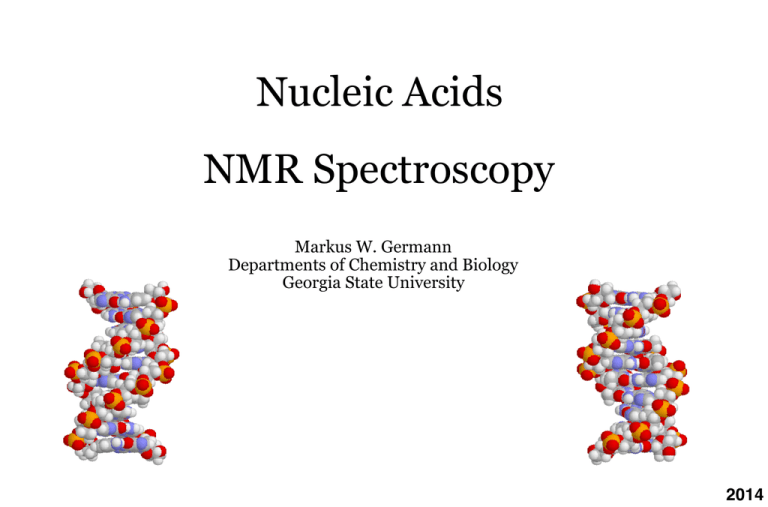
Nucleic Acids NMR Spectroscopy Markus W. Germann Departments of Chemistry and Biology Georgia State University 2014! NMR of Nucleic Acids 1 ! ! 1) Primary Structure of DNA and RNA! 2) Resonance Assignment of DNA/RNA by Homonuclear NMR! A) B) C) D) E) 1H Chemical shifts ! Assignment of exchangeable protons! Assignment of non-exchangeable proton! Typical NOEs in helical structures! Correlation between non-exchangeable ! !and exchangeable protons! NMR Spectroscopy is an Important Method for Structural Studies of Nucleic Acids: PDB Holding, March 21, 2012! Molecule! Technique! Proteins! X-ray Diffraction! Protein/Nucleic ! Acid Complexes! Other! 65’703! 1’266! 3’331! -! 70’302! 8’163! 933! 228! -! 9’331! 430! 24! 122! -! 492! 74’294! 2’223! 3’681! -! 80’264! NMR! Other 1)! total! Nucleic Acids! 1) EM, Hybrid, other! http://www.rcsb.org/pdb Alternate Bases & Modifications (small selection): HETERO BASE PAIRS H H3 C N N H O H N N N H N N N H + N N O H H N N H N H N N O O Hoogsteen H H H 3C O H N N H O N N N N N H N N N O O H H N N H O H H N N N H3 C O H O N N N N N Watson-Crick O N N H N N N N H Reverse Watson-Crick N N N HH N H Germann et al., Methods in Enzymology (1995), 261, 207-225. Nucleic acids: structures, properties, and functions (2000) By Victor A. Bloomfield, Donald M. Crothers, Ignacio Tinoco HOMO BASE PAIRS H O H N H N N + N N N H H O CC + O O CH3 N N CH3 H H O CH3 N O N N O H N O N H N O TT(I) H3 C H N N N N N N N H N H N N O N N O N H N TT(II) NH 2 N H N O N H NH 2 AA(II) N H N H N H N H H N N H N O N H N N N N H N N N N N GG(II) N N AA(I) N N O H H GG(I) Germann et al., Methods in Enzymology (1995), 261, 207-225. Nucleic acids: structures, properties, and functions (2000) By Victor A. Bloomfield, Donald M. Crothers, Ignacio Tinoco Structure Determination: I) Assignment II) Local Analysis •glycosidic torsion angle, sugar puckering, backbone conformation base pairing Global Analysis •sequential, inter strand/cross strand, dipolar coupling III) Nucleic Acids have few protons….. •NOE accuracy > account for spin diffusion •Backbone may be difficult to fully characterize > especially α and ζ. •Dipolar couplings Chemical shift ranges in nucleic acids! NH (G, T, U)! NH2 (G, C, A)! ! A-T! G-C! A-U! ! Loops, MM! Loops, MM! H2, H8, H6! H2, H8, H6! H1’! H3’! H4’,H5’,H5’’! H2’,H2’’! H1’! H2’,H3’,H4’,H5’,H5’’! DNA! RNA! G-C! 15! 10! 5! 0! RNA! DNA! H1' H2' H2'' H3' H4' H5' H5'' 5-6! H1' 2.3-2.9(A,G) 1.7-2.3(T,C)! H2' 2.4-3.1(A,G) 2.1-2.7(T,C)! H3' 4.4-5.2! H4' 3.8-4.3! H5' 3.8-4.3! H5'' 3.8-4.3! C1' C2' C3' C4' C5' 83-89! 35-38! 70-78! 82-86! 63-68! C1' C2' C3' C4' C5' 5-6! 4.4-5.0 4.4-5.2! 3.8-4.3! 3.8-4.3! 3.8-4.3! 87-94! 70-78! 70-78! 82-86! 63-68! 9R-Borano DNA•RNA! 5’-d(A T G G T G C T C)! (u a c c a c g a g)r-5’! Adenine ! ! !Guanine! ! H2 H8 N6H - !C2 !C8 !N6 !152-156 !137-142 !82-84 !!149-151 !119-121 !157-158 !214-216 !220-226 !224-232 !166-172 !!H8 !N1H !N2H ! ! ! ! !7.5-8 !7.7-8.5 !5-6/7-8 !! ! ! ! ! ! !C4 !C5 !C6 !N1 !N3 !N7 !N9 ! !!7.5-8.3 !12-13.6 !5-6/8-9 ! ! ! ! ! ! ! !C2 !C8 !N1 !N2 !C4 !C5 !C6 !N1 !N3 !N7 !N9 !156! !131-138! !146-149! !72-76 ! !152-154 ! !117-119 ! !161 ! !146-149! !167 ! !228-238 ! !166-172! ! Thymidine! ! ! !! !Uridine H6 Me5 N3H - !H6 !6.9-7.9 !C6 !H5 !5.0-6.0 !C5 !N3H!13-14 !N3 !- !- ! !! ! ! !C2 ! ! ! !C4 ! ! ! !C5 ! ! ! !N1 !6.9-7.9!C6 !137-142 !1.0-1.9!Me5 !15-20 !13-14 !N3 !156 !!- !! !C2 154 ! !C4 169 ! !C5 !95-112 ! !N1 !144 ! ! !Cytidine! !137-142 !102-107 !156-162 ! !154 !169 !102-107 !142-146 !H6 !6.9-7.9 !C6 !136-144! !H5 !5.0-6.0 !C5 !94-99! !- !!N3 !210 !! !N4H!6.7-7/81-8.8!N4 !94-98 ! ! ! !C2 !159! ! ! !C4 !166-168! ! ! !C5 !94-99! ! ! !N1 !150-156! No Structure Required! Often, depending on the question asked, a full structure determination is not required ! Does it form a duplex? ! Which base pairs are thermo labile? ! Which base pair is which… assignment? ! Is the loop structured? ! Structure DNA Hairpin Thermal lability! Germann et al., Nucl. Acids Res. 1990 18: 1489-1498 AT! GC! T! imino 1H NMR 31P “New” DNAG9constructs G3 ! O 5´-5´ T6 ! Do the duplexes form, is there alpha base pairing? G ! ! α O O ! Does the unusualG1base pair form? ! !! CH 3 ! O ! O alpha C G9 T6 alpha T G1 C1! ! O β G3 N ! G3 ! alpha A O T6 !! CH 3 O ! G9/G1 T7 ! G3 G1 T7 NH ! HN G9 N O T6 T7 C1! 3´-3´ ! T7 NMRO! 5’-G C C G G A A C α!T! T T α!T! C A A G G C C! G-5’! 5’-G C C G G C T A G C C! G-5’! G9/G1 T7 T6 G3 control 14.0 13.5 13.0 12.5 ppm 1.0 0.5 0.0 A T A T -0.5 -1.0 T A C G -1.5 ppm WNV-RNA RNA 1! 7bp! G48! G50! RNA 4! U49! RNA 2! 11bp! U20! U64! ! 5bp G54! G62! G26! G18! RNA 4! GAGA! U22! G61! G! G! U28! ! A A 40! A A A C G C G A U RNA 1! A G C G A U C G 50! G C G 30!U A C G U A C A G C U A C C A U A 60! G 10! U A U G A C G C G 20!U A G U! A U G! A G C G U G A U C 3’! C RNA 4! RNA 3! ! + 4U! RNA 2! 5’! G! RNA 3! 19bp! RNA 5; RNA 6 G10->C! RNA 5! Fibrinogen Specific DNA Aptamer A 288K B 308K Figure 2: 12% Native PAGE to observe mobilities of Ap90. Ap90 is compared to single stranded oligomers of various lengths. The lanes were loaded from the smallest to the largest sequences with Lane A-E containing the 10-mer, 18-mer, 30-mer, 50-mer, and the 90-mer respectively. Lane F contains the aptamer Ap90. The smear in lane F encompassing a large range of DNA sizes (~90 nucleotides - ~30 nucleotides) indicates that the aptamer has multiple conformations.! Hamilton & Germann 2011 Solvent Suppression The presence of an intense solvent resonance necessitates an impractical high dynamic range. 110 M vs <1mM (down to 5-10 uM) To overcome this problem several methods are currently applied: 1) Presaturation 2) Observing the FID when the water passes a null condition after a 180 degree pulse. 3) Suppression of broad lined based on their T2 behavior. 4) Selectively excitation, with and without gradients 5a) Use of GRASP to select specific coherences thereby excluding the intense solvent signal. In this case the solvent signal never reaches the ADC. This allows the observation of resonances that are buried under the solvent peak. 5b) Use of GRASP to selectively dephase the solvent resonance (WATERGATE) 5c) Excitation sculpting ! Presat Selective Excitation 90 90 P18 P18 x 180 y td td SINGLE LINE ON RESONANCE Presaturation field strength: 20-40 Hz corresponds to a 6-12ms 90deg pulse Pros: Easy to set up Excellent water suppression Cons: Resonances under water signal! (T variation) Labile protons not visible (some GC pairs may be) ! Bo Bz My M =0 Selective rf pulse on solvent resonance followed by a gradient pulse to dephase the waterBsignal. z This could be followed by a mild presaturation field. The selective rf pulse (1-2ms, depending on width to be zeroed) is usually of the gauss type. The selective rf pulse z-gradient constructs could be repeated (WET). ! Jump and return 90 -x 90 x d1 Watergate td z 90 x 180 x 90 -x 90 -x Δ Δ z y y x Δ y Δ x solvent G z +1 +1 p 1G 1 + p2G 2 ...... = 0 Pros: Easy to set up Excellent water suppression (with proper setup as good as presat) Good for broad signals! Cons: Non uniform excitation Baseline not flat Other sequences: 1331 etc ! Pros: Cons: ! Water! Excellent water suppression Uniform excitation Baseline flat May loose broad resonances Exitation Sculpting T.-L. Hwang & A.J. Shaka, J. Mag. Res. (1995), 112 275-279! 1D! Pros: Easy to set up Excellent water suppression “ok” for broad signals! Uniform excitation Cons: May loose some intensity on very broad signals Spectra: 1.5mM DNA in Water, Nanjunda, Wilson and Germann unpublished! NOESY! Interesting structures have often broad imino protons. àMost modern techniques obliterate them. A" B" Jump and return !7˚$C$ to the rescue ppm 5.0 4.5 4.0 3.5 ppm 3.0 + supercooled conditions 3.5 5'- G C T A C G C αA G T G C G C A T C G G C -5' 4.0 4.5 5.0 !8˚$C$ ppm +17˚$C$ +7˚$C$ 3.5 4.0 4.5 +17˚$C$ 5.0 Spring, A.M. & Germann, M.W., Anal. Biochem., 2012.! 14.0 13.8 13.6 13.4 13.2 13.0 12.8 12.6 12.4 ppm 1 2 3 4 6 7 8 9 10 ! ! 5’-G C T A C G C α!A! G G T C G C A T C G 5 G! C-5’! 20 19 18 17 16 15 14 13 12 11! αA5 H2! C4 H5! ppm! 6.0! 6.5! T2!T 13! G12! G1! G6! G7! G17! G 18! G10! C 4 A N! 7.0! αA5 H2! 7.5! 8.0! T16! C 4 A B! 8.5! G17Im! Structure Determination, NMR experiments: I) Assignment II) Local Analysis •glycosidic torsion angle •sugar puckering •backbone conformation •base pairing (NOE, COSY) (COSY, COSY, NOE, +) (COSY, +) (NOE, COSY) Global Analysis •sequential •inter strand/cross strand •dipolar coupling (NOE, COSY) (NOE, COSY) (HSQC, HSQC) III) NOESY, COSY, HSQC TOCSY…… Black: unlabeled, Blue: labeled DNA or RNA Stereospecific Assignment O! H5!'!! H5!'!'! B! O! H3!'!! H2!'!! H4!'!! H2!'!'! O! H1!'!! 2’’! Deoxyribose! O! 2’! H2ʼʼ H2ʼ H5ʼ H5ʼʼ H5!'!! H5!'!'! H3!'!! B! O! H2!'!! H4!'!! How do we determine them? H1!'!! O! OH! Ribose! 0 ppm a) Rule of Thumb (5’ downfield of 5’’) Shugar and Remin BBRC (1972), 48, 636-642) b) Short mixing times NOESY dH1’H2” shorter than H1’H2’ -> Crosspeak H1’-H2’’ > H1’H2’ 0 ppm Structure Determination: I) Assignment II) Local Analysis •glycosidic torsion angle, sugar puckering,backbone conformation base pairing Global Analysis •sequential, inter strand/cross strand, dipolar coupling III) Nucleic Acids have few protons….. •NOE accuracy > account for spin diffusion •Backbone may be difficult to fully characterize > especially α and ζ. •Dipolar couplings Distance information determines the glycosidic torsion angle 3.8Å! 2.5Å! ! How do we get distance information? o Nuclear Overhauser effect (< 6Å) Distance information determines the glycosidic torsion angle 3.8Å! 2.5Å! ! How do we get distance information? o Nuclear Overhauser effect (< 6Å) Sugar puckering! The five membered furanose ring is not planar. It can be puckered in an envelope form (E) with 4 atoms in a plane or it can be in a twist form. The geometry is defined by two parameters: the pseudorotation phase angle (P) and the pucker amplitude (Φ). In general: RNA (A type double helix) C3' endo. DNA (B type double helix) C2' endo. = m cos (P + 144 (j-2)) m range: 34° - 42° O3’ 2’endo! α = 3+ 125° nucleotide unit j 3’endo! β γ ν4 ν3 δ ε ν2 O4’ χ ν0 ν1 N (Northern)! 5’! 3’endo! (Angle ~ 90 deg)! 5’! 2’endo! S! (Angle ~ 170 deg)! (Southern)! 2’endo sugar H1’, H2’, H2”, H3’ region! H1’! H3’! H2”! H2’! Widmer,H. and Wüthrich,K. (1987) J. Magn. Reson., 74, 316-336. 3’endo sugar H1’, H2’, H2”, H3’ region! H1’! H3’! H2”! H2’! Sugar puckering! H1’! H1’! H3’! H3’! H2’! H2’! H2”! H2”! 3’endo sugar! 2’endo sugar! H1’! LFA- COSY! 2’endo sugar H1’, H2’, H2” region! H2’’! H2’! 90 45 t1 Sugar puckering! C3´-endo C2´-exo: P = 0°! J1’2’ 2 Hz (with P = 9) N! C2´-endo: P = 162°! J1’2’ 9 Hz (with P = 144) S! In a 50/50 situation the measured J 1’2’ is 5.5 Hz which would! correspond to P of 70 degree.! Sugar puckering! Usually (DNA) one observes equilibrium of the S and N forms sugar repuckering. Unless one form greatly dominates the local analysis requires quite a few parameters: PN , PS , ΦN , ΦS , fS Several methods for analysis exist, graphical and the more rigorous simulation. In practice the desired outcome determines the effort to be made. Sums of the coupling constants are often easier to obtain. fS = (Σ 1’ –9.8)/5.9 Σ 1’ = J 1’2’ + J 1’2’’ Σ 2’ = J 1’2’ + J 2’3’ + J 2’2’’ Σ 2’’ = J 1’2’’ + J 2’’3’ + J 2’2’’ Σ 3’ = J 2’3’ + J 2’’3’ + J 3’4’ See also our pure examples: fS=0 and ~1 respectively If fs < 50% J1’ 2’ < J1’ 2’’ If fs ca 0% J1’ 2’ very small If fs > 70% J1’ 2’ > J1’ 2’’ Sugar puckering! Nt control Σ1´ fs alphaT Σ1´ fs alphaC Σ1´ fs alphaT! alphaA alphaG 5’-G Σ1´ C fs G AΣ1´ A Tfs α!T! C C G C α!T! T A A G 0.81 14.3 0.76 14.9 0.86 G1 15.2 0.92 15.3 0.93 14.6 C2 15.1 0.90 14.7 0.83 15.0 0.88 15.0 0.88 0.86 16.0 1.00 9.4 - 300 T6 G C C! G-5’! (15.3) (0.93) 30 G3 16.2 1.00 15.9 1.00 14.9 A4 16.2 1.00 15.3 0.93 15.3 0.93 100 10.7 - 14.5 0.80 A5 15.7 1.00 15.3 0.93 15.1 0 0.90 12.1 0.39 14.9 0.86 T6 15.1 0.90 15.3 0.93 14.7 300 0.83 αT7 14.6 0.81 14.8 0.84 T7 16.0 1.00 12.3 - 200 (15.3) P (0.93) 15.0 0.88 15.6 0.98 20 C8 15.1 0.90 12.9 0.53 9.5 G9 15.7 1.00 14.7 0.83 13.5 C10 (14) (0.7) (14) (0.7) (14) 200 100 20 10 0 30 - 15.0 0.88 14.4 0.82 10 0.63 14.3 0.76 14.9 0.86 0 30 (14) (0.7) (14) (0.7) 20 0 300 C8 (0.7) 200 100 10 0 0 40 80 Time (ps) Aramini, 2000, J. Biomolecular NMR, 18, 287-302 % 120 160 0 120 240 0 P MD calculation! MD-Tar calculation! Pseurot calculations! ΦS,N != 37°! PS != 125-165 ! fS ! != 0.44-0.55! ΦS,N != 37°! PS != 130-155! fS ! != 0.78-0.86! ! ! ! ! Aramini, et al., 1998, Nucleic Acid Research, 26, 5644-5654 van Wijk,J., Haasnoot,K., de Leeuw,F., Huckreide,D. and Altona,C. (1995) PSEUROT 6.2. A Program for the Conformational Analysis of Five Membered Rings. University of Leiden, The Netherlands Introduction to Cross-Correlated Relaxation Relaxation in NMR à determines experimental strategies and experiments à dynamic and structural parameters Mechanisms à Dipole -dipole à CSA (e.g. 31P at higher fields; proportional to B2) à Scalar relaxation (first and second kind) à paramagnetic, etc Recently it became possible to use cross correlated relaxation (CCR) to directly measure bond angles without using a calibration curve as is needed for J’s. à DD -DD à DD -CSA θ Sugar Puckering from Cross-Correlated Relaxation Γ DD-DD ΓC1’H1’-C2’H2’ = k (3cos2θ-1)τc θ = 180: for 2’endo (B form) Large and positive θ = 90: for 3’endo (A form) Small and negative Pseudorotation Phase Angle θ1’2’ = 121.4°+1.03 ψm cos(P-144°) BioNMR in Drug Research (2003) Chapter 7 p147-178. Christian Griesinger Sugar puckering: Summary! à Coupling constants: COSY, E.COSY, low flip angle COSY! !Homonuclear, Heteronuclear! à CT NOESY! à CSA-DD and DD-DD cross correlated data! à 13C chemical shifts, in favorable cases! Some references! ! Szyperski, T., et al. (1998). JACS. 120, 821- 822. Measurement of Deoxyribose 3JHH Scalar Couplings Reveals Protein-Binding Induced Changes in the Sugar Puckers of the DNA. Iwahara J, et al. (2001), J. Mag Res. 2001, 153, 262 An efficient NMR experiment for analyzing sugar-puckering in unlabeled DNA:. Couplings via constant time NOESY. J. Boisbouvier, B. Brutscher, A. Pardi, D. Marion, and J.-P. Simorre (2000), J. Am. Chem. Soc. 122, 6779–6780 NMR determination of sugar-puckers in nucleic acids form CSA-dipolar cross correlated relaxation. BioNMR in Drug Research 2003 Editor(s): Oliver Zerbe (Wiley-VCH) Methods for the Measurement of Angle Restraints from Scalar, Dipolar Couplings and from Cross-Correlated Relaxation: Application to Biomacromolecules Chapter 7 p147-178. Christian Griesinger (also for α and ζ) ! O3’ nucleotide unit α β γ ν4 ν3 δ ε O4’ χ ν0 α and ζ pose problems! Determinants of 31P chem shift.! ! ε and ζ correlate. ζ = -317-1.23 ε ! ν1 ν2 ζ O5’ + NOE! + NOE! Backbone Experiments: CT-NOESY, CT-COSY Bax, A., Tjandra, N., Zhengrong, W., ( 2001). Measurements of 1H-31P dipolar couplings in a DNA oligonucleotide by constant time NOESY difference spectroscopy, J. Mol. Biol., 19, 367-270. 91.
